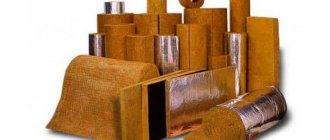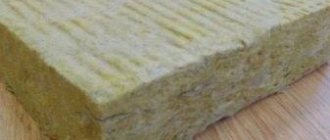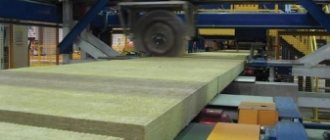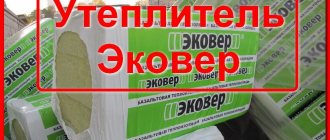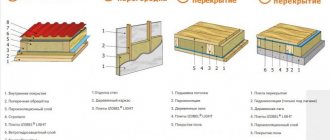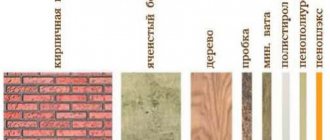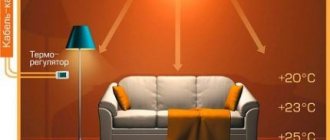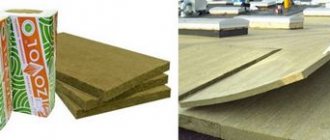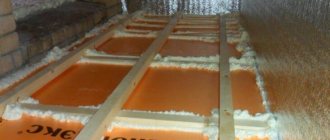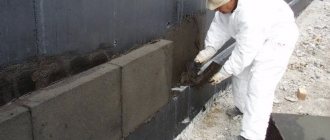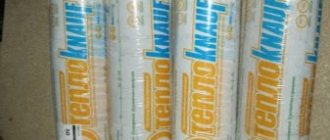Stone wool today is rightfully considered one of the best heat and sound insulating materials. Especially in terms of sound insulation, because such a large number of voids between the fibers perfectly damps sound waves. And that's not all!
Thanks to its elasticity, modern basalt insulation fits quite tightly to the frame and neutralizes any cold bridges. Even over time, it does not lose its shape and properties, and all thanks to its unique structure.
Who would have thought that one day soft insulation for the home would be made from real stone? But this is really so! We invite you to find out how this is done, who is engaged in production today and where such materials are used.
How is stone made soft and fluffy?
Let's reveal a secret: to turn a real stone into soft cotton wool, it is melted in an oven at a temperature of 1300-1500 degrees Celsius. Only at this temperature does basalt become liquid. It drips into a rapidly rotating large flywheel, or immediately seeps through micro-holes into the centrifuge - depending on what technology is used in production.
There, organic matter is added to the fibers formed from the droplets. Fibers under different pressures are formed into mats and slabs. This is how stone wool reaches its final microstructure and density:
In real life this process looks like this:
Interesting, isn't it?
TechnoNIKOL (Ryazan, Yurga, Khabarovsk, Zainsk, Chelyabinsk)
TechnoNIKOL is the only domestic manufacturer of insulation based on mineral fibers, which is recognized not only in the Russian Federation, but also in the Baltic countries and Europe. Production sites have been organized in 35 countries, supplies of materials have been established in 80 countries.
The proposed mineral wool is not the only product of the company, but research and development activities are also carried out with it. Therefore, today there is real access to an impressive assortment (almost 50 options).
TechnoNIKOL presents the following product lines:
- Private construction (Technofas, Technoflor, Technoruf);
- Professional construction (Technosandwich, Technoflor Pro, Basalit) construction;
- Technical insulation (Mat and Cylinder Techno, Lamellar, Stitched);
- Special options for fire protection (Techno OZB, Techno OZM).
The production involves raw materials from rocks of the gabbro-basalt group, which determines the environmental purity of the material. Other advantages are determined by the properties and characteristics of TechnoNIKOL mineral wool (fiber melting point - 1000 0C, low thermal conductivity and vapor permeability, wide range of density indicators).
The disadvantage is the binder based on formaldehyde resins.
Which explains the strict safety requirements when laying TechnoNIKOL mineral wool. Main characteristics of TechnoNIKOL
| Technoflor standard | Techno 35 lamel mat | Technofas cottage | |
| Purpose | Sound and thermal insulation of the floor | Acoustic and thermal insulation of curved walls | Insulation of facade under plaster |
| Dimensions, mm | 1 200x600x30 | 8 000х1200х30 | 1 200x600x200 |
| Density, kg/m³ | 99 | 38 | 115 |
| Thermal conductivity, W/(m K) | 0.037 | 0.04 | 0.037 |
| Quantity per package(pieces/m²/m³) | 8 / 5.76 / 0.1728 | 1 / 3.6 / 0.288 | 1 / 0.72 / 0.144 |
| Price, rub/m³ | 4 200 | 3 187 | 4 476 |
Video review of TechnoNIKOL products:
Valuable advantages of ready-made basalt insulation
The modern Russian market offers a wide variety of insulating materials for home improvement, both high-quality and not so good. But if you have basalt thermal insulation from a trusted manufacturer, then you don’t have to worry about many things. It is quite easy to install and fireproof, unlike many other types of thermal insulation.
For example, stone wool fibers can withstand a melting temperature of more than 1000 degrees Celsius - this is reached after no less than 2 hours of a strong fire. At the same time, foam products not only cannot withstand such heat, but also spread the fire themselves.
Here is an interesting promotional video that clearly demonstrates all these points:
Basalt wool really has such valuable properties as fire resistance, moisture resistance and resistance to deformation:
This kind of insulation seems unrealistically ideal, wouldn’t you agree? Considering that a lot of effort is spent on it and rocks are melted, why not.
Beltep (Belarus: Gomel)
Until 2007, the Belarusian enterprise Gomelstroymaterialy worked with varying efficiency and mainly for the domestic market. The popularity of high-quality and relatively inexpensive materials has become an incentive to develop a network of trading houses in the Republic of Belarus and to search for dealers outside the republic. Thus, almost 10 years ago Beltep mineral wool appeared on the construction market of the Russian Federation.
Small assortment:
- for roofing (RUF);
- for external walls (Vent, Facade)
- for internal walls and partitions (Light)
- on the floor and ceilings (Flor).
In the total mass of the main groups, there are 20 brands of mineral wool insulation. But interest in the products is actively maintained by updating the product list. Today these are materials with an impressive range of data on the main characteristics.
Pros: large selection of sizes, stable quality of each batch.
Disadvantages: low elasticity and a lot of dust during installation.
Main characteristics of Beltep
| Light Extra | Ecolight | Station wagon | |
| Purpose | Insulation of roofs and facade systems | Thermal insulation of walls and ceilings indoors | Construction and technical insulation |
| Dimensions, mm | 1,000-1,200x500,600,1,000x100-150-200 | 1,000-1,200x500,600,1,000x40-200 | 1,000-1,200x500,600,1,000x30-200 |
| Density, kg/m³ | 25 (±5) | 50 (-10, +5) | 60 (-5, +10) |
| Thermal conductivity, W/(m K) | 0.032 | 0.04 | 0.036 |
| Quantity per package(pieces/m²/m³) | The configuration, area and volume depend on the combination of dimensions for a unit of material | ||
| Price, rub/m³ | 1 460 | 1 600 | 1 880 |
Video about the manufacturer Beltep:
Technical characteristics and form of insulation
Now let's take a closer look at exactly what characteristics basalt wool has and how it compares favorably with other similar insulation materials:
- thermal conductivity ranges from 0.034 to 0.045 W/μ;
- strength at deformation of 10% from 10-55 kpa;
- moisture absorption – from 1 to 5%. By the way, materials with even higher values, but not more than 20%, are also suitable for internal insulation.
- the density of basalt slabs for internal insulation is 30-50 kg/m³, and for external insulation 100-400 kg/m³;
- vapor permeability is in the range of 0.4-0.6 mg/m.h.pa.
Let's compare basalt wool with other types of mineral insulation, because in appearance and installation technology they are almost identical:
Let us dwell in more detail on vapor permeability. For internal insulation of walls and roofs, the ability to pass water vapor through its structure without trapping it under a vapor barrier film is important. But how do they get there?
The fact is that not a single vapor barrier film is completely impenetrable to water molecules. The only such material is aluminum sheet. All other options have vapor permeability to one degree or another. For example, cheap vapor barrier films can retain water vapor by only 75%, but more expensive ones can retain 90-95%. But these 5% can cause a lot of trouble.
And finally, to the question of the environmental friendliness of this insulation. Stone wool, due to its non-flammability, does not ignite from open fire, and the flame itself does not spread over its surface either. But many are worried about the toxicity of this material to humans when heated to high temperatures.
The fact is that when exposed to heat above 1000 degrees, stone fibers begin to melt and deform, but it is the binders that begin to burn out on them first. However, their quantity on the material is too small to form a smoke screen or poison the air.
But what will happen next to the fibers? They will begin to melt. At the same time, stone wool can withstand 240 minutes of direct exposure to flame without deformation, thus serving as a certain fire protection for the home. Here are more details about the fire safety of the material:
And a short introductory video on other issues that worry the population in our difficult times:
Ursa (Serpukhov, Chudovo)
The insulation of the Uralita Group concern has been known for its low thermal conductivity for more than 5 years, and today it is presented in six options in different sizes. The young, innovative material “Ursa Pureone”, with a smaller range of dimensions, also managed to receive positive recommendations from professional builders.
Ursa is suitable for:
- roof thermal insulation (Pureone, Geo);
- insulation of facades (Terra);
- performing interior work (Geo Light).
The main advantage of the materials in the Ursa Terra line is their resistance to biological influences. With the correct design of the insulation system, neither rodents nor bacteria are able to adapt both from the inside and in the external walls of the building.
Ursa Pureone has improved environmental and performance characteristics.
The negative aspects of Ursa insulation appear when the rules of transportation and storage are violated.
Ursa Key Features
| URSA TERRA 34 PN PRO | URSA PUREONE 37RN | URSA PUREONE 35QN | |
| Purpose | Acoustic ceiling, soundproofing wall with external insulation | Insulation of pitched roofs, ceilings and walls | Thermal insulation of frame house walls, attic floors |
| Dimensions, mm | 1 250x610x50 | 6 250x610x50 | 3 900х1 200х150 |
| Density, kg/m³ | 20 | 18 | 20 |
| Thermal conductivity, W/(m K) | 0.036 | 0.037 | 0.035 |
| Quantity per package(pieces/m²/m³) | 5 / 3.81 / 0.381 | 2 / 15 / 0.75 | 1 / 4.68 / 0.702 |
| Price, rub/m³ | 1 319 | 1 602 | 2 945 |
Video about Ursa products:
Forms: rolls, plates and foil materials
To say that one form is better and another is worse would be wrong. Specifically, for insulating the roof of a house, soft or hard slabs are most often used, plus special sandwiches for chimneys.
Thus, soft slabs are well suited for insulation and sound insulation of smooth, unloaded surfaces, including inclined ones. Those. These are the places that need to be protected from the cold, but there is no heavy load on them. These are mainly interior partitions, roofing system between rafters and insulation of floors between joists in the subfloor.
But slabs of medium hardness are usually used for external insulation. For example, for ventilated facades or in well masonry. These are also suitable for rooms with high humidity; by the way, special stone wool is produced for this purpose, or rather, a separate series of it.
Rigid stone wool slabs can already withstand loads of up to 300 kg per square meter. They are necessary when insulating floors in the so-called floating screed. They are also used for wet facades; we are talking about special rigid slabs, whose tensile strength must be at least 10 kpA, and a reinforcing decorative layer is laid directly on them.
But why not use such slabs to insulate the walls or roof of a house, you ask? Aren't they better and more reliable than soft ones? The fact is that the stiffer the plates, the higher their thermal conductivity, unfortunately. The main guideline when selecting stone wool for insulating a specific part of the house is still the manufacturer’s recommendations.
All physical and mechanical characteristics of heat-insulating materials are clearly calculated for their specific tasks. That is why the material for walls and roofs must be elastic, and for screeds it must be rigid. And stiffness and elasticity are directly affected by the size of the fibers, the raw materials used and much more.
For the same roof, lightweight elastic slabs are quite suitable; they can be easily placed in the required space, and they will hold on due to their weight and expansion force. But if you install denser material between the rafters, it risks being damaged. Therefore, in case of installation, you should not try to do better than the manufacturer could come up with.
Let us note another new type - foil-coated basalt insulation with an aluminum backing or a fiberglass base. On one side, as you may have guessed, there is aluminum foil. This is a wonderful finishing material for insulating saunas and baths.
In this case, the slabs themselves are placed with foil inside the room, and it reflects heat rays, and the fibers do not allow the cold to pass through from the outside. Also, sometimes basalt wool is additionally reinforced with wire or stitched with fiberglass threads.
Paroc (Tver region)
Finnish insulation material Paroc with Swedish roots. Known for its impressive range and decent technical characteristics. Since 2013, full-fledged production of Paroc mineral wool has been established in the Russian Federation.
Plate and roll materials, thermo-wound cylinders, pressed bends and segments from the conveyor belt of a Russian plant have the same indicators as imported insulation. Packed in the same shrink film.
Paroc mineral wool is suitable for:
- roof insulation (ROB);
- foundation and floor (GRS);
- internal walls and partitions (Extra Light);
- façade (WAS), fire protection (FPS) and soundproofing (SSB) systems.
The impressive list of options for the general construction plan is complemented by materials from the category of technical insulation (Pro, Hvac), for heating and ventilation systems, large-scale technological processes, and industrial equipment.
The positive features of Paroc mineral wool are laid down at the structural level - the material is elastic and does not break (and therefore does not generate dust) during installation. Many compatriots will appreciate the manufacturer’s offer to produce the required batch according to the customer’s dimensions.
The disadvantages of cooperation include the relatively high cost and the need for a thorough study of the offered range.
The choice is large, so in the event of an unintentional mistake, there is a high probability of unjustified cost overruns. Main characteristics of Paroc
| PAROC eXtra | PAROC WPS 3n | PAROC GRS 20 | |
| Purpose | Insulation of facades and walls under plaster | Thermal insulation of a ventilated facade | Insulation of floors using joists and soil |
| Dimensions, mm | 1 220x555x50 | 1 200х600х30-70 | 1 200x600x50-140 |
| Density, kg/m³ | 30 | 100 | 90 |
| Thermal conductivity, W/(m K) | 0.04 | 0.04 | 0.037 |
| Quantity per package(pieces/m²/m³) | 14 / 10.42 / 0.521 | Depends on the dimensions of the material | |
| Price, rub/m³ | 2 156 | 6 703 | 5 750 |
Video about Paroc products:
Review of manufacturers, or what does the Russian market offer?
Let's look at which manufacturers today supply stone wool to the domestic market of insulating materials:
Knauf: recognized world leader
The most famous manufacturer of stone wool in the whole world is the German concern Knauf. He began producing products in 1932, and in the field of thermal insulation he mainly specializes in basalt fiber, although he sometimes produces fiberglass materials.
Knauf has a fairly well thought out choice of insulation for different house structures; for this purpose, they produce as many as five series: for the roof, and for the walls, and for the ceiling and partitions. Knauf also has universal mineral wool, which is suitable for any task:
Today Knauf produces stone wool literally for the whole world. But, unfortunately, buyers often complain about the increased rigidity of the slabs, which prick.
Of course, it’s not like glass wool; it’s more likely that there’s just an unpleasant sensation when working with bare hands. On the other hand, no one abroad would even think of working with cotton insulation without gloves.
Rockwool: high quality
No less famous is Rockwool - a Danish company operating since 1909. All its factories use only European equipment, which the company is especially proud of. Stone wool is supplied in the following forms:
By the way, Rockwool also has factories in Russia. Among other advantages of this basalt insulation, users usually note that it does not crumble or shrink, and also pleases with a wide selection of sizes and packaging. Those. It’s quite easy to choose the right option for building your home.
Ursa: expensive equipment
But Ursa have developed a new line of mineral wool. In fact, these are three entire production sites operating as the Ursa Eurasia association. Their main trump card is high-tech equipment. Previously, they worked more with fiberglass slabs, but today they use more natural basalt raw materials with acrylic-containing components.
Urs also has factories in Russia, namely in the city of Chudnovo. According to the manufacturer, new high-tech equipment from Europe was also imported there, and therefore you don’t have to worry about quality.
And Russia especially liked the Pureone series. By the way, this manufacturer’s basalt insulation is considered one of the best in terms of sound and heat insulation, although it has insufficient vapor permeability, as some complain.
TechnoNIKOL: for special loads
TechnoNIKOL is one of the most famous manufacturers of basalt insulation in Russia, producing its products under the Rocklight brand:
Interestingly, each TechnoNIKOL enterprise has its own laboratory. Thanks to this, multi-stage control is constantly carried out over the products. As a result, TechnoNIKOL received a European level certificate for its products.
And at one time, TechnoNIKOL modernized its production lines and was able to achieve a rather unique property of mineral wool - increased rigidity, thanks to which each basalt slab can withstand a load of up to 7 tons. The manufacturer is also trying to make the insulation unattractive to small rodents, since they really love such materials.
But, unfortunately, this insulation still has problems with hydrophobicity. There are also sometimes reports that mice especially love this mineral wool, and new slabs sometimes have an unpleasant chemical smell.
Isover: enviable durability
Basalt wool from the French company Isover has been produced for a very long time - more than 80 years. Such slabs are good because even over many years they do not change their shape and do not lose their properties.
Among the disadvantages, only poor moisture resistance and the repulsive odor of the material are noted.
Izovol: the best fire safety
Good technical characteristics are also noted for basalt wool brand Izovol. It is produced at the Belgorod plant, in accordance with the requirements of both domestic and foreign standards.
For example, mineral wool from Izovol is famous for its improved fire safety. And therefore, such products are used not only for private, but also for industrial construction, especially for pipe insulation. The whole secret is that Izovol produces its wool using a completely different technology than its competitors - it melts all components with gas.
This technology uses a unique melting device, which allows the production of fibers through a constant high melt temperature, thus providing the desired fluidity and viscosity. This allows us to achieve slightly different technical characteristics of fibers than competitors' products.
Izovol is proud that no blast furnace slag is used to make its stone wool. Finished basalt wool is supplied to the CIS countries as having such advantages as lightness, non-flammability and a fairly wide range of applications. But among the shortcomings they indicate slight shedding during the installation process.
Isorok: domestic quality
We’ll also tell you a little about mineral wool from the Isorok company. It has been produced in Russia since 2000. The main difference is their universal characteristics: the slabs are dense and stable, and cope well with the tasks of heat and sound insulation. Among other insulation materials, this stone wool takes its rightful place.
Paroc: reliability and practicality
Another popular manufacturer is the Finnish Paroc. It produces energy-efficient panels and basalt wool. There are Paroc factories in Russia, and its products can often be seen at Moscow construction exhibitions.
Among the advantages of basalt wool of this particular brand are its harmlessness and fire safety. Disadvantages: slight dust during operation and low-density slabs are not of the best quality.
But you will be interested to know that Paroc today occupies a leading position in the production of mineral wool throughout the world. According to the manufacturer himself, the whole secret of their success is in the coherence of the staff. Therefore, you should definitely trust this brand.
Euroizol: unique technology
The manufacturer Euroizol generally uses an interesting technology for the production of stone wool. The threads are stretched in a special way, due to which they become longer and the diameter of the fiber increases. And this improves the technical properties of the insulation. Even when working with such a slab, you will probably notice that the wool is more flexible and durable.
The secret is that the longer the fibers, the greater the compressive, tensile and shear strength. And a larger diameter of the threads improves heat-conducting and sound-absorbing properties during operation.
Thanks to these innovations, Euroizol was able to launch a line of lighter and more cost-effective insulating materials, since with such fiber it is possible to make them of lower density. This means the load on the roof will be reduced.
Beltep: proven wear resistance
The Belarusian Beltep, beloved by many, is in the budget segment. This wool has good vapor permeability and high rigidity.
Beltep products are designed for insulation of private houses and for industrial use. Its main advantage and marketing emphasis is the wear resistance of the products. True, the slabs have a certain pungent odor due to the phenolic resins contained inside, which disappears over time.
Which manufacturer's mineral wool is better?
The companies from our rating produce high-quality products worthy of the attention of a demanding buyer. Each company has its own advantages, so it is difficult to answer the question of which mineral wool is better. These are large concerns that offer insulation for various areas of construction. The VyborExperta.ru team recommends choosing a supplier taking into account the area of activity:
- Rockwool is the best insulation for pitched roofs;
- Isover – products for thermal insulation of facades and interfloor ceilings;
- TechnoNIKOL is a universal budget solution;
- Paroc – mineral wool for used roofs and facades.
All presented brands deserve the title of the best manufacturers. These companies produce products that will last at least 50 years, keeping your home warm and cozy.
Dry installation technology (ventilated facade)
When mounting the frame, its slats are placed so that the distance between them is 1-2 cm less than the width of the slab or roll of basalt wool. In this way, a tight installation is achieved. Work on installing the sheathing begins from the corners of the building, using a level and a cord to install the guides in the same plane.
The roll is rolled out from top to bottom. The slabs, on the contrary, are placed from bottom to top. Having filled all the rows of the sheathing with insulation, a vapor barrier film is fixed to it, which performs the function of wind protection. The joints of the film sheets are glued with construction tape. After this, holes are drilled in the wall and plastic dowels are hammered into them, securing the mineral wool and the wind barrier.
The next operation is to attach counter-battens (second sheathing) to the frame, creating a ventilated gap between the insulation and the outer cladding of the facade.
Design for dry wall insulation (ventilated façade)
The general rule for installing mineral wool slabs is to prevent the joints of the insulation from matching the corners of door and window openings.
Basalt slabs can be installed in one or two layers. It all depends on the selected thickness of insulation.
Some manuals suggest two-layer installation as a way to protect joints from blowing. In this case, the slabs are mounted so that the upper ones cover the joints between the lower ones. With this option, the sheathing has to be placed in two rows, perpendicular to one another.
With two-layer installation, maximum tightness of insulation is achieved
Flaws
Despite their manufacturability, basalt insulation materials can generate dust during installation and preparation. To protect the eyes, respiratory system and skin, the worker must use special protective equipment: mask, goggles, gloves and long sleeves.
Another feature of stone wool is the likelihood of getting wet in case of direct contact with water. Basalt does not absorb moisture, but when exposed to rain, it can accumulate it in the voids between the fibers. It will be impossible to dry the insulation after such an incident. Therefore, it is important to store insulating materials in a dry, closed area before starting installation work.
Isover - high quality mineral wool to choose from
Photo: atlaccapital.ru
The manufacturer offers two solutions: glass wool and stone wool. This is a big plus when choosing thermal insulation, since both of these materials are usually in demand in the construction of a particular facility. Izover has an excellent reputation in Russia and offers thermal insulation only with environmental quality certificates. The constant introduction of modern technologies makes it possible to improve the characteristics of manufactured products and reduce costs. The latest “new product” from Isover is the release of mineral wool with high strength and elasticity, without dust and with a minimum of “prickliness”. In terms of quality, products under this brand are unlikely to compare with more expensive competitors, but in terms of price/quality ratio, Isover mineral wool is one of the best.
Rating : 9.9 points out of 10
Reviews from builders : “Isover mineral wool is cheaper and better than many other insulation materials, so I use it for large volumes.”
Binder
This insulation product always contains a binder. It binds the fibers and gives the desired density and shape. Types of binder:
— bitumen;
- synthetic, usually phenol-formaldehyde, phenol alcohols or urea resins.
- compositional (complex composition of several substances).
- bentonite clays.
Manufacturers most often use a composite binder. This is a synthetic composition that includes plasticizing and water-repellent additives, as well as phenol-formaldehyde resins. In the final material, formaldehyde and phenol are combined, and the binder is completely inert.
